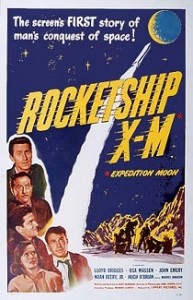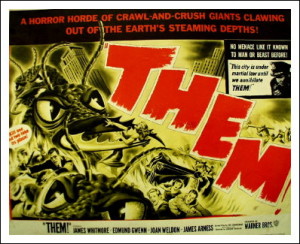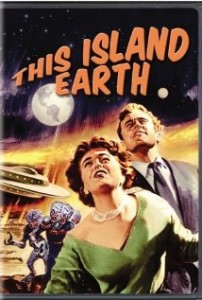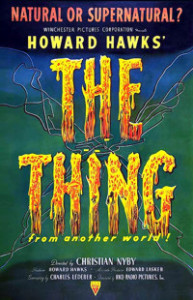Space Travel, Alien Invasions, and Atomic Monsters: The Best 1950s Science Fiction Films
There are no movies more fun to watch than 1950s science fiction. The first of these films went from the sublime to the ridiculous, from Invasion of the Body Snatchers (1956) to Cat Women of the Moon (1953). But they all had something for fans who couldn’t get enough of the exciting and popular new genre. The results were mixed but when they were good, they were very good.
The first wave of films appealed mostly to the young who were growing up in the Golden Age of Science Fiction. The genre went from the books fans were reading to movies easily. The special effects were new and exciting for viewers who accepted that space travel was possible, there was life on other planets and there were fantastic things on Earth yet to be discovered.
Science fiction films of the 1950s have a well-deserved reputation for being cheesy; most were low budget “B” films done by studio subsidiaries with short shooting schedules and unknown actors. There was a lot of duplication of plot lines and gimmicks: “radiation” was used to explain anything and everything (radiated ants, scorpions, spiders, leeches, and crabs all had their own movie), the lead player was often a scientist or military man who tried to kindle a romantic relationship with the smart but distant female scientist, and the U.S. Army always got involved as the military and government were glorified and portrayed as being able to defend the world against any extraterrestrial intruders. And let’s not forget the ubiquitous Theremin.
Here then are some favorites from the archives of 1950s science fiction films, broken down into three ascending categories.
I. The Good
Rocketship X-M (1950) was the first science fiction film, rushed through production to beat out Destination Moon (1950). Headed for the moon, X-M is put off course and forced to make an emergency landing on Mars. This movie answers the question of whether or not 
Producers seemed on more solid footing with alien invasions as the Earth became a magnet for unreasonable aliens. And the humans who greeted them quickly learned that it was best to shoot first and ask questions later. The central character in Invaders from Mars (1953) is a young boy, a star gazer and avid science fiction reader who sees a space ship land in a field beyond his house. No one believes him and soon people start disappearing only to return strangely changed. The Martian’s mission is to stop rocket experiments on Earth, but they are no match for the Army which comes in and destroys the ship and its occupants. In The Atomic Submarine (1959), the crew of the Tigershark 
As if alien invaders weren’t bad enough, we had our own homegrown creatures to deal with. Atomic bomb testing had its consequences and there were some decidedly negative effects on animal life here on the planet. The best of the atomic mutant monster films is Them! (1954). Bomb tests in New Mexico have spawned giant killer ants that are reproducing and threaten humanity. Being ants they are, of course, well organized and fly to Los Angeles where they wage war in the storm sewers under the city. The pitched battle that ensues is a showdown of biblical proportions between the military and the creatures that their ill-advised bomb tests have spawned.
Others: It Came from Beneath the Sea (1955), It! The Terror from Beyond Space (1958), Earth vs. the Flying Saucers (1956)
II. The Very Good
Runner ups for the best 1950s science fiction films include a collection of very watchable movies. A deep space observatory in South Africa discovers that two planets are on a collision course with Earth in When Worlds Collide (1951). Much debate in the international scientific community discredits the findings as the world’s governments try to calm the masses. One planet, Zyra, will miss while Bellus 
Not all aliens are bad and in Ray Bradbury’s It Came from Outer Space (1953) they are downright enlightened. On their way to another planet, aliens are forced to make a crash landing on Earth which is witnessed by our two lead players, an astronomer and his school teacher girlfriend. The hideous looking aliens can transform themselves into any form by touch, shape shifting into humans in order to collect the equipment they need to repair their ship. They don’t want to hurt anyone and just want to be on their way, but the local sheriff has a different idea and puts together a posse to destroy the ship and kill its occupants. This film has a strong message about understanding and tolerance as the monstrous appearance of the friendly visitors causes fear among the townsfolk.
Others: Donovan’s Brain (1953), X: The Unknown (1956), Spaceways (1953)
III. The Best
Invasion of The Body Snatchers was one of the best films of the 1950s regardless of genre. It had a big time director, some name actors, and almost no special effects. Seeds drifting thru space find their way to Earth where they grow into pods that morph into the 
Science fiction in the 1950s also portrayed ignorant humans as the real menace. The Day the Earth Stood Still (1951) is brilliant in its portrayal of the humanoid Klaatu, the most sympathetic alien in any science fiction film of the era. This alien is not an invader only an ambassador but the first thing the humans do is shoot him anyway. Klaatu has a message of great importance to Earth but will only deliver it when he can address the leaders of all the nations together. He demonstrates his power by shutting down all electrical power on the planet except for hospitals, planes in flight, etc.
Klaatu is more compassionate than the humans he wants to save, but the Earthlings aren’t buying it. After being shot and taken to the hospital, he escapes and blends in with the humans calling himself “Mr. Carpenter.” The religious subtext, as well as the statement on a united world government, makes this film the most thought provoking, and controversial, of all 1950s science fiction movies.
In H. G. Wells’ The War of The Worlds (1953) humanity is up against a full blown, all out alien invasion. A university scientist and a 
Forbidden Planet (1956) is the best of the space travel films. Shot in Cinemascope, it is beautifully photographed with elaborate sets, very good special effects and period-specific science fiction music. In the 23rd century, “hyper drive” allows spaceships to travel at the speed of light. The United Planets have colonized worlds all over the galaxy and our crew travels to Altair IV to investigate the fate of colonists who have not been heard from in twenty years. The sole survivors are Dr. Morbius and his 19-year-old daughter Altaira. Morbius tries to persuade the crew to leave 
Widely considered one of the best science fiction movies ever made, The Thing from Another World (1951) is a very serious film that had a decent budget, a no-name cast, and one of the top directors in the business – Howard Hawks. The setting for the showdown with an extraterrestrial is in one of the most other worldly places on Earth: the Arctic. An Air Force crew, investigating what appears to be a plane crash, discovers a flying saucer buried below the icy surface. They bring the seemingly dead pilot back to the nearby research station; but it is alive, a blood drinking alien who is bigger, stronger, and angrier than the small band of scientists and flyboys. A battle at the top of the world that could determine the fate of Earth ensues.
When the crew first discovers the alien ship just visible under the ice, they spread out, each standing on an edge so they can determine the size and shape of the craft. They look up to discover that they are standing in a circle. They have found a flying saucer. It is still one of the best scenes in any science fiction film.
Others: The Incredible Shrinking Man (1957), The Fly (1958)
Gregory Small
Latest posts by Gregory Small (see all)
- The Best B-Movies of the 21st Century - May 26, 2015
- From Vampires to Cave Girls: The History of Hammer Films - October 14, 2014
- Space Travel, Alien Invasions, and Atomic Monsters: The Best 1950s Science Fiction Films - June 11, 2014


